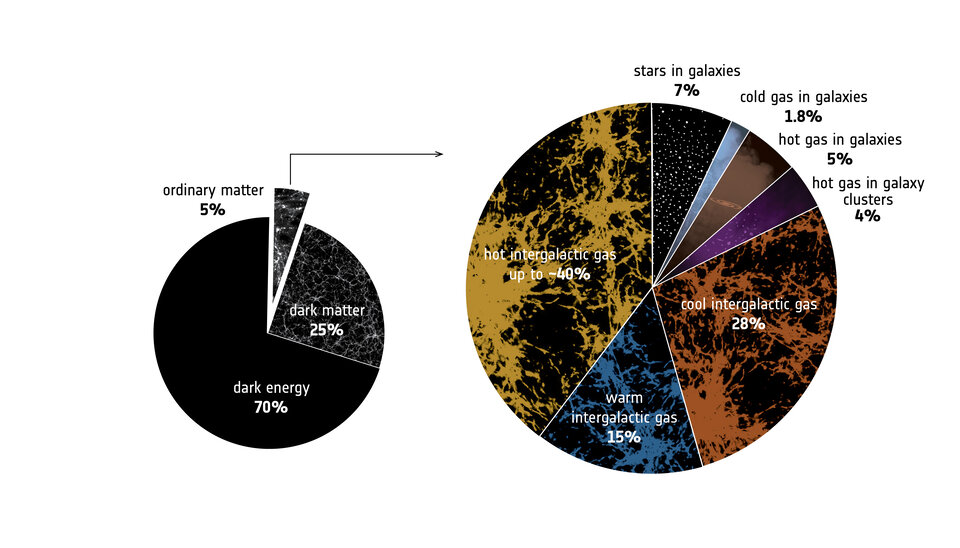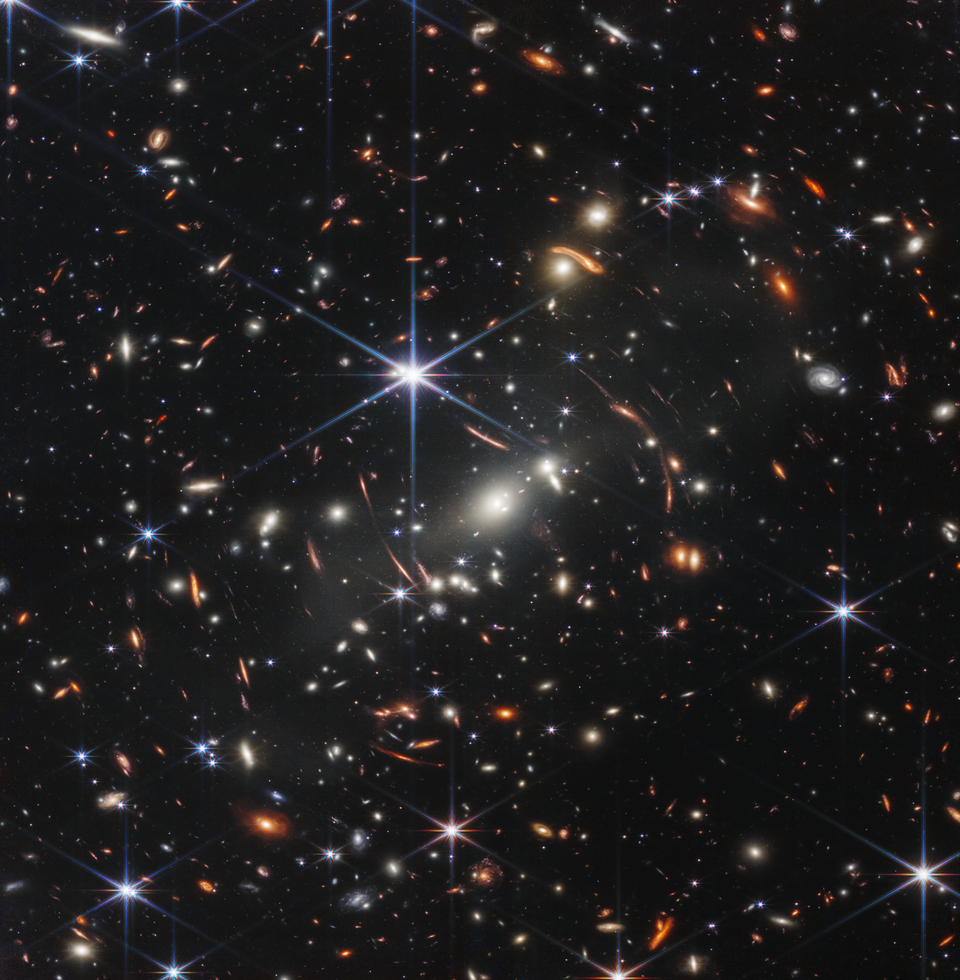The dark Universe
The Euclid mission aims to uncover the mysteries of the dark Universe. This ominous-sounding invisible part of the cosmos makes up more than 95% of the mass and energy in our Universe. But what is it?
The light side of the Universe

You and me, everything that we can touch and smell, and all planets, moons and stars are made of ‘normal’ matter. Normal matter consists of the elemental particles described in the famous Standard Model of particle physics. This includes quarks and electrons, which together form atoms.
We know that normal matter attracts other normal matter, depending on how much mass it has, via gravity. This force explains why apples fall towards the Earth. It also explains why the Earth revolves around the Sun, and the Sun orbits the centre of the Milky Way galaxy.
Surprisingly, normal matter turns out to be only a small fraction of what the Universe contains. 95% of the Universe is made up of dark matter and dark energy. These are words astronomers have come up with to give a name to the mysterious, invisible side of the Universe.
Dark matter
By studying many different galaxies, scientists discovered that stars in galaxies move faster around their galaxy centres than what the matter we see could account for. On its own, normal matter would not be able to create enough gravity to hold these galaxies together. It’s no small difference: a typical galaxy’s missing mass is ten times larger than the mass of its visible stars!
Scientists can also tell that there is some unknown material in the space between galaxies, because its gravitational pull influences the path of starlight travelling towards Earth. Matter can act like a magnifying glass, bending and distorting light from galaxies and clusters behind it. This effect is called gravitational lensing.

Years of extensive observations have shown that the missing gravity is not caused by hard-to-see normal matter, such as for example cold hydrogen atoms. Instead, astronomers must look beyond what is known.
We call the missing mass ‘dark matter’ because it appears that it only interacts with light and normal matter via gravity. The most precise experiments so far have not found evidence of any other interactions. And despite decades of research, we still don’t know what dark matter is made of.
Euclid will make detailed observations of the Universe to infer how dark matter is distributed. It will determine how the structure of matter in the Universe changed over time and measure gravitational lensing effects. This will teach us about the behaviour of this mysterious component and provide new clues as to its identity.
Dark energy
Measurements in the 1990s showed that the rate at which the Universe expands is accelerating. This was completely unexpected because nothing in known physics could produce this effect. The Universe has continuously expanded since the Big Bang, but it was assumed that this expansion rate would slow down over time because it is resisted by the gravity of all matter in the Universe.
In keeping with the naming of the mysterious dark matter, astronomers began referring to whatever was causing the acceleration as ‘dark energy’. This unidentified component of the Universe is thought to be present in such a large quantity that it overwhelms all other components of matter and energy put together. According to the most recent estimates from ESA's Planck mission, dark energy contributes 68 percent of the matter-energy density of the Universe.
This 68 percent value is found by tuning parameters in the famous ‘concordance’ model of the Universe until its output matches our observations. Dark energy is included in this model as a ‘cosmological constant’, which describes an intrinsic property of the vacuum of space that is the same at any point in the Universe. The larger the volume of space, the more vacuum energy (dark energy) is present and the greater its effects.
But dark energy might not be a constant, instead it could be changing over time. Or perhaps it is a new fundamental force of nature, joining the four forces we know of now (electromagnetic, weak and strong interactions, and gravitation). Or, more drastically, could we be misunderstanding how gravity – described by Einstein’s theory of general relativity – works?
Today, understanding the nature of dark energy remains one of the most compelling challenges of cosmology and fundamental physics. Thus far, no experiment has been capable of measuring the acceleration of the Universe’s expansion in sufficient detail to distinguish between the possible solutions. Until now.
Euclid has been designed to reach unprecedented levels of observational accuracy, with which it will precisely map the distribution of galaxies over the last 10 billion years of cosmic history across more than a third of the sky. This 'looking back in time' will reveal the precise way dark energy has accelerated the expansion of the Universe. Measuring changes in this acceleration to an accuracy of better than 10 percent, Euclid will show whether the cosmological constant is indeed constant.
By mapping the evolution of cosmic structures such as galaxies and galaxy clusters, we can also directly test general relativity itself. Importantly, no previous test of the theory has been made with this precision over such large distances and times. Euclid will measure 'gamma', a cosmological parameter describing structure growth, to within an accuracy of 2 percent. If the test finds that general relativity does not hold, we will have to find a new theory.
What we know about the history of cosmic structure formation in depth



